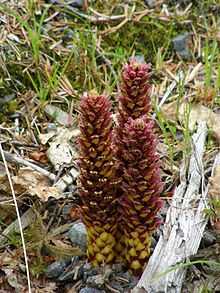Boschniakia rossica
| Boschniakia rossica | |
|---|---|
 | |
| Scientific classification | |
| Kingdom: | Plantae |
| (unranked): | Angiosperms |
| (unranked): | Eudicots |
| (unranked): | Asterids |
| Order: | Lamiales |
| Family: | Orobanchaceae |
| Genus: | Boschniakia |
| Species: | B. rossica |
| Binomial name | |
| Boschniakia rossica (Cham. & Schltdl.) B.Fedtsch. | |
| Synonyms | |
|
Orobanche rossica Cham. & Schltdl. | |
Boschniakia rossica, commonly known as the northern groundcone, is a holoparasitic plant that lives in the northern latitudes of the northern hemisphere.In the Pacific Northwest Temperate Rainforest, it does not grow south of Prince of Wales Island, beyond that boundary is the Vancouver groundcone habitat. It does not contain chlorophyll, so it must be parasitic to obtain nutrients. It specializes on Alnus species, but can parasitize off of other trees and shrubs such as on Betula (birch), Salix (willow), Vaccinium (blueberry), Picea (spruce) and Chamaedaphne (leatherleaf shrub). This organism is likely to be found at mid elevations alongside rivers and streams, where moisture is abundant. This species propagates itself through water flow. In some places bears are known to have eaten the starchy roots, or tubers, of this plant.
Morphology: B rossica grows between 6-12 inches, with 2 or 3 stems per individual. It has tall slender stalks. The roots grow horizontally from a main bulbous mass. It can vary from very dark maroon to reddish brown in color. This is a perennial plant, and flowers every summer. It can produce up to 300,000 seeds. B. rossica very much looks like a pinecone growing up out of the ground.
Traditional aspect: In China, B. rossica is considered a ̱̱̱Traditional Chinese medicine. In the Changbai Nature Reserve, it is considered a protected and endangered species. B. rossica has many traditional applications including: cleansing and nourishing the kidneys in tonic form, cures impotence in men, strengthens the heart, used in invigorating tonics, eases constipation, is used on skin rashes, it has anti-aging effects, used in conjunction with other herbs to increase memory retention. In some First Nations and Native American cultures the whole plant is dried, ground, and used as a topical application, and sometimes smoked in a pipe.
Traditional and other names: Poque – other common name Cao-cong-rong (China) Oniku (Japan) Orinamudcobusali (Korea) Du’iinahshèe (Gwichya Gwich'in) Doo’iinahshìh/Ts'eedichi (Teetå'it Gwich'in) Tulukkam nauligaafa (Inuit) Uktschutsch (Kamtschadalis)
Modern Science: Scientists and researchers from all over the world, though mainly from China, Japan, Korea,and Russia, have tested and analyzed B. rossica for its medicinal properties. They have found that this plant has exceptional anti-inflammatory properties that work for heat burns,chemical burns, scalds, allergic reactions,and arthritis. Tests were done to determine if there was an application for treatment of tumors. Scientists from the Institute of Cancer Research, Yanbian University College of Medicine in Yanji used the GST-Pi marker enzyme in their experiments. They used this particular one because it has clinical importance in marking tumors of hepatoma, esophageal, gastric, and colonic carcinomas and its preneoplastic lesions. They discovered that applications of B. rossica had extraordinary anti-oxidant properties, and is being further researched for cancer cures and prevention. Other studies have been conducted to test the anti-aging properties of B. rossica, and has been shown to cure senility in rats. Genetic analyses have been conducted on B. rossica to determine its phylogeny. There are many ways to phylogenetically classify B. rossica, but scientists from Ohio State University have determined that the family Orobanchaceae is estimated to have originated about 52.2 million years ago.[1] The strongest bootstrap support is for terminal clades. The most parsimonious tree of Boschniakia forms a grade with Conopholis and Epifagus as well as other species of Orobanche. In this tree, Lindenbergia and Schwalbea are sister taxa. These are still hypotheses, and further research is being conducted.
There are two GenBank numbers referring to Boschniakia rossica: AY911214, and rps2;ITS : DQ403779; AY911214.
Notes
References
1. Wolfe, Andrea D; Randle, Christopher P; Liu, Liang; Steiner, Kim E (2005). "Phylogeny and Biogeography of Orobanchaceae". Folia Geobotanica 40: 115–134. doi:10.1007/bf02803229.
2. Qu, Baihong; Li, Wei; Chen, Yanqui; Liu, Jisheng (2011). "Protection versus culture-driven exploitation of wild plant resources: the case on Changbai Mountain". International Journal of Sustainable Development & World Ecology: 404–411.
3. Guo, Ji-Xian et al., eds. (2001). International Collation of Traditional and Folk Medicine v.4. River Edge, NJ: World Scientific.
4. Park, Jeong-Mi; Manen, Jean-François; Colwell, Alison E.; Schneeweiss, Gerald M. (2008). "A plastid gene phylogeny of the non-photosynthetic parasitic Orobranche (Orobanchaceae) and related genera". Journal of Plant Research: 365–376.
5. Quan, Jishy; Piao, Long; Xu, Huixian; Li, Tian; Yin, Xuezhe (2009). "Protective effect of iridoid glucosides from Boschniakia rossica on acute liver injury induced by carbon tetrachloride in rats". Biosci, Biotechnical, Biochem: 849–854.
6. Kruckeberg, A R (1983). "Temperate Floras: The North Pacific Connection". Annals of the Missouri Botanical Garden: 591–596.
7. Wang, Zhenghui; Wu, Baojun; Zhang, Xianghong; Xu, Min; Chang, Huimin; Lu, Xiaoyun; Ren, Xiaoyong. "Purification of a polysaccharide from Boschniakia rossica and its synergistic antitumor effect combined with 5-Fluorouracil". Carbohydrate Polymers 212: 31–35.
8. Yin, Zong Zhu; Jin, Hai Ling; Yin, Xue Zhe; Li, Tian Zhu; Quan, Ji Shu; Jin, Zeng Nan (2000). "Effect of Boschniakia rossica on expression of GST_P, p52 and p21ras proteins in early stage of chemical hepatocarcinogenesis and its anti-inflammatory activities in rats". World Journal of Gastroenterology: 812–818.
9. ^http://plants.gwichin.ca/node/30
10. ^http://orowiki.org/wiki/Boschniakia_rossica
11. ^http://www.projectnoah.org/spottings/35890023
12. ^http://linnet.geog.ubc.ca/Atlas/Atlas.aspx?sciname=Boschniakia%20rossica
14. ^Zhang, Zhi-Yun; Tzvelev, Nikolai N. (1998). "Orobanchaceae". Flora of China v.18. p. 239. Retrieved December 8, 2013.
15. ^http://www.itis.gov/servlet/SingleRpt/SingleRpt?search_topic=TSN&search_value=34270